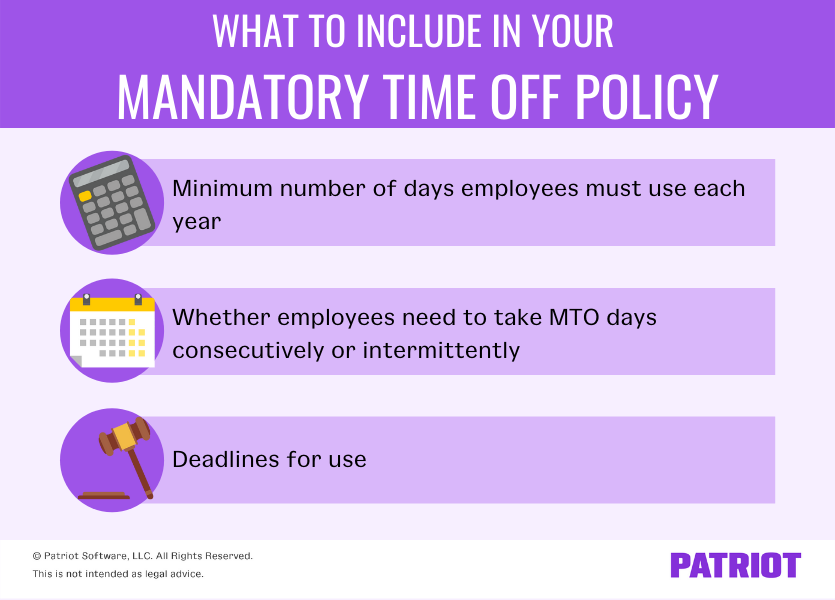So, you’ve decided to give your hard-working employees paid time off (PTO). You’ve drafted a clear PTO policy that details the benefit. But, nobody’s taking their time off. What gives? In an effort to force workaholics to take a vacation, some businesses are shifting gears and implementing mandatory time off.
Should you? Read on to learn about mandatory PTO, benefits, and best practices for creating a mandatory vacation policy.
What is mandatory time off?
Mandatory time off, or minimum PTO, is a policy where employers require employees to take at least a certain number of days off from work each year. While away from work, employees receive their regular wages.
A mandatory time off (MTO) policy accompanies paid time off or unlimited paid time off policies. Both paid time off and unlimited paid time off policies let employees receive their regular wages while away from work.
However, a regular PTO policy gives employees a set number of days they can take off per year. An unlimited PTO policy gives employees an unlimited number of days they can take off per year.
Regardless of whether you have a regular PTO or unlimited PTO policy, you may notice that some of your employees refuse to take time off.
| Want a better way to track how many days off your employees have left? Try Patriot’s Time & Attendance software add-on and payroll software! The best part? You can get both for FREE today. |
MTO with a regular PTO policy
Companies with regular PTO policies generally give employees with leftover time off at the end of the year one or more of the following options:
- Roll it over
- Cash it out
- Forfeit it (i.e., a use-it-or-lose-it vacation policy)
Letting employees cash out their time could lead to cash flow problems at year-end. And, letting employees roll over time may cause scheduling challenges in the following year.
Adding a minimum PTO requirement is a positive spin on implementing a use-it-or-lose-it policy, which is banned in some states. Forced vacation encourages employees to take a break from work by requiring it.
MTO with an unlimited PTO policy
In businesses with unlimited paid time off, employees might not be sure what an appropriate amount of time off looks like. So, some employees may err on the side of caution and avoid taking too much time off. This could lead to stress, worry, and burnout.
Unlike a regular PTO policy, employees don’t get to roll over or cash out unused time. MTO can encourage employees to take advantage of their unlimited time off by requiring them to use a set number of days.
Benefits of mandatory PTO
Implementing a mandatory PTO policy isn’t just beneficial for your team members. It also benefits your business.
By requiring employees to take a minimum number of days off work, you can help:
- Avoid high cashouts / rollovers at the end of the year (regular PTO policy)
- Curb employee burnout from lack of days away from work
- Encourage a positive work-life balance
- Increase employee engagement and productivity
- Improve your employer brand
- Increase employee retention
When discussing the benefits of minimum PTO, Ravi Parikh, CEO of RoverPass, shared:
Just as our brains need breaks and time to rest during the day, we need breaks from work altogether from time-to-time. Instead of trudging along a path that will inevitably lead to burnout, employees should be encouraged to take a minimum amount of time off for their own mental health. Make sure these days are paid, otherwise they won’t ever take time off for resting!”
In addition, implementing mandatory paid time off could give you a chance to review details about the employee’s position. You might find out other employees are able to step up when the employee is out.
Like anything else, consider the cons of requiring employees to take paid time off. You could run into scheduling issues and employee confusion if your policy isn’t clear. To avoid these types of issues, you can follow…
Best practices for writing your mandatory vacation time policy
When you offer employees time off from work, you need a policy detailing the ins and outs of the program. Your forced leave policy is the central hub of information employees can refer to with questions or concerns.
Likewise, you must write up a detailed minimum PTO policy to go with your PTO or unlimited PTO policy.
Before creating your MTO policy, check your state’s laws. Some states have time off rules that could impact your PTO and MTO policies, including:
- Use-it-or-lose-it bans
- Paid sick leave laws by state
Ready to craft a confusion-free mandatory vacation time policy? Include the following key points in your mandatory PTO policy:
- The minimum number of days employees must use each year
- Whether employees need to take mandatory days off consecutively or intermittently
- Deadlines for use

The minimum number of days employees must use each year
First things first: What’s the minimum number of days each employee needs to use each year? Remember, this isn’t the total number of days the employee has available to them. This is the minimum amount of time they must take off.
You might choose to set different minimums for employees, based on their number of years with your business. An employee with more experience might have a higher minimum number of days than a newer employee.
Take a look at this mandatory vacation policy example:
- Minimum PTO for employees with 1-5 years experience: 15 days / year
- Minimum PTO for employees with 5+ years experience: 20 days / year
Whether employees need to take MTO days consecutively or intermittently
You can choose between requiring employees to take a certain amount of time off consecutively or intermittently throughout the year.
For example, you might require employees take off at least:
- One consecutive week
- Five days intermittently
- One day off per month
Some employers set a minimum time off requirement employees must take in one block of time. This encourages employees to take enough time off from work to rejuvenate.
Other employers set a minimum number of days employees must take annually, but the employee can take them at their leisure (e.g., a day here and there).
Whatever you decide, spell it out in your policy. Make sure employees know what you require of them when it comes to giving them paid vacations.
Deadlines for use
What is the cutoff for when employees must use their mandatory time off? Do you require mandatory time off during a specific time of the year (e.g., down season)?
Requiring employees to take some of their PTO during specific periods can be beneficial to your business. According to David Fernandez, CEO & Founder of Capital Dealer Solutions:
Requiring paid leave at a set time creates a predictable period during which the company will be aware that employees would be absent. This enables the organization to budget for employee vacation time and ensures that personnel are available and working during peak seasons.”
You can approach your mandatory time off policy in a number of ways. You might set:
- Annual deadlines
- Quarterly deadlines
- Monthly deadlines
Last but not least, detail what happens if an employee doesn’t take their mandatory time off by the deadlines.
For example, you might require the employee to take off the last few days of the year if they still have remaining MTO. Or, you could determine the employee’s mandatory vacation days for them if they don’t schedule their days off by a certain date.
This is not intended as legal advice; for more information, please click here.